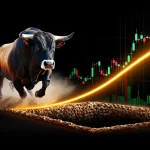
Understanding the Russell 2000 Futures: A Dance with the Devil or a Path to Profits?
June 7, 2024
In the wild and treacherous world of investing, where fortunes are made and lost, the masses are forever seeking the next big thing—a magic bullet to beat the markets. And so, they turn to exotic financial instruments like the Russell 2000 futures, hoping to time their moves to perfection. But, as H.L. Mencken so aptly put it, “For every complex problem, there is an answer that is clear, simple, and wrong.”
The Russell 2000 futures are indeed a strategic financial instrument, a forward-looking crystal ball tethered to the Russell 2000 Index—a motley crew of 2,000 small-cap stocks. This derivative contract is like a siren, luring investors with the promise of untold riches. But, as Jonathan Swift warned, “Vision is the art of seeing things invisible.” The masses often fail to see that timing the market is a fool’s errand, a dance with the devil.
The problem with the masses is that they’re like sheep, blindly following the herd. They try to time the market, to ride the waves, without first learning to control their emotions. Plato wisely observed, “The first and best victory is to conquer self.” Until you master your own greed and fear, you will always be a slave to the markets.
When used by those with knowledge, discipline, and self-control, the Russell 2000 futures can indeed provide a nuanced understanding of market dynamics. They can also be a powerful tool for navigating the treacherous terrain of small-cap stocks, which make up the Russell 2000 ETF (IWM). This exchange-traded fund mirrors the performance of the Russell 2000 Index, giving investors a front-row seat to the wild ride of small-cap equities.
The symbiotic relationship between the Russell 2000 futures and the IWM ETF is like a financial ballet, a strategic dance that reveals the hidden rhythms of the market. But, it is not for the faint of heart or the undisciplined. As Mencken said, “Horse sense is the thing a horse has which keeps it from betting on people.” So, before you try to time your entries and exits, ensure you understand the beast you’re dealing with.
In conclusion, the Russell 2000 futures can be a double-edged sword. It can empower astute investors with strategic insight, but it can also lead the unprepared down a path of ruin. So, before you try to dance with the devil, make sure you know the steps, control your emotions, and remember the wise words of Plato: “The measure of a man is what he does with power.”
The Correlation between Russell 2000 Futures and IWM
Using Russell 2000 Futures for Market Timing
The Benefits of Russell 2000 Futures:
The decision to incorporate Russell 2000 futures into an investment strategy offers advantages that extend beyond convenience. The liquidity of futures contracts enables seamless transactions, allowing investors to act agilely in a dynamic market environment. This liquidity, a hallmark of futures, empowers investors to enter or exit positions swiftly in response to evolving conditions.
The allure of Russell 2000 futures is further enhanced by their leverage. This feature amplifies investors’ control over a substantial portion of the underlying asset with a modest capital investment. While this presents an enticing prospect for maximizing returns, Machiavelli would caution that “fortune is like a woman: it is won by feigning indifference.” In other words, investors must balance ambition with caution, as leverage magnifies risk.
The futures market’s extended trading hours provide another advantage. It operates nearly 24 hours daily and transcends geographical and temporal boundaries, offering real-time information on market sentiment and potential price movements. This continuous market accessibility empowers investors to adapt to global shifts and news cycles, aligning with Mark Twain’s wisdom: “The secret of getting ahead is getting started and knowing when to get started.”
The combination of liquidity, leverage, and continuous market access positions Russell 2000 futures as a dynamic tool for astute investors. It enables them to navigate the market with precision and adaptability, capitalizing on opportunities and managing risks. As Charlie Munger wisely advised, “The first rule is that you can’t really know anything if you just remember isolated facts and try and bang them back. If the facts don’t hang together on a latticework of theory, you don’t have them in a usable form.”
Risks and Considerations:
While the benefits of using Russell 2000 futures for timing entries are apparent, prudent investors like Charlie Munger must navigate the inherent risks and complexities of futures trading. As Munger cautioned, “All I want to know is where I’m going to die, so I’ll never go there.” This underscores the importance of understanding the challenges and uncertainties in the financial markets.
Futures trading demands a comprehensive grasp of the intricate dynamics governing futures contracts and derivative instruments. Investors must recognize the impact of broad market trends, economic indicators, business cycle changes, and investor sentiment on the Russell 2000 Index. Machiavelli would advise that “the first method for estimating the intelligence of a ruler is to look at the men he has around him.” In this case, seeking advice from seasoned investors or advisors could be beneficial.
Although futures prices offer insights into potential future market movements, they are not infallible. Investors must exercise caution and incorporate other market indicators and factors into their decision-making process. Relying solely on future data could lead to incomplete insights. As Munger advised, “You need a few things in life that are not quantifiable, that are just wisdom.”
A balanced and informed approach is crucial when integrating Russell 2000 into an investment strategy. Investors must be vigilant, continuously educate themselves, and adapt to changing market conditions. As Mark Twain wisely stated, “It ain’t what you don’t know that gets you into trouble. It’s what you know for sure that just ain’t so.”
In conclusion, whileit offers a valuable tool, a nuanced approach is essential. Investors should recognize the risks and complexities of futures trading and acknowledge the limitations of predictive data. By adopting a holistic decision-making process and committing to continuous learning, investors can effectively leverage this tool to make well-informed decisions.
Exceptional Perspectives: Expand Your Horizons
Unlocking Investor Psychology: Thrive in the Market’s Mind Game










